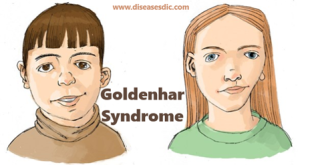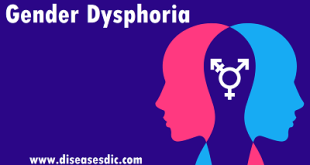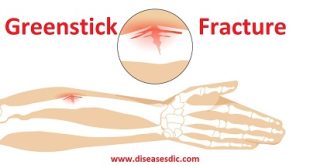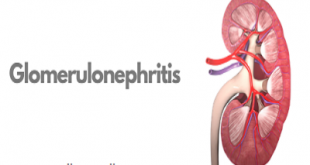Definition
A ganglion cyst is a soft-to-firm, round growth located on the wrist joint. Usually about 1-3 cm in diameter, it is nonmobile. It can be found most commonly on the dorsal aspect of the wrist but can occur on the volar side as well. This benign growth is tethered to the wrist joint by a stalk known as the pedicle. Less frequently, the pedicle may anchor the ganglion cyst to a flexor tendon in the wrist. The fluid contained within the walls of the cyst is thick and gelatinous and is structurally different from the synovial fluid found in other joints. It is not associated with any underlying inflammatory process.
In some cases, a smaller ganglion cyst is nestled between the wrist joint and overlying tissues. Because of its size and covert location, this type of ganglion cyst may not be visible to the naked eye. A high degree of suspicion from an experienced clinician is needed to search for these occult ganglion cysts.
Pathogenesis of ganglion cyst
- The pathogenesis of ganglions is unknown or uncertain. The most widely held belief is that cysts form as a result of mucoid degeneration of collagen and connective tissues.
- This explanation implies that a ganglion represents a degenerative structure that houses the myxoid changes of connective tissue. A recent theory suggests that cysts form after a trauma or soft tissue irritation.
- As a result of trauma, modified synovial cells lining the synovial capsular interface are stimulated to produce mucin, specifically hyaluronic acid.
- Mucin dissects along the attached joint ligament and capsule to form capsular ducts. These function as valve-like structures producing lakes. The ducts and lakes of mucin coalesce to eventually form a cyst
Epidemiology
- Can affect all age groups. Unusual in children
- Most common in ages 20 to 40 years and twice as common in women
- Common in the dorsal wrist, radial wrist, and dorsum of the distal interphalangeal (DIP) joint (referred to as a mucous cyst)
- Mucous cysts are usually seen in older patients.
- 60–70% of hand and wrist ganglion cysts are on the dorsal wrist; 15–20% are on the volar wrist.
- Prevalence of wrist ganglia in patients presenting with wrist pain is as high as 19%.
- Prevalence of ganglia in patients with a palpable mass in the wrist is as high as 27%.
- The reported prevalence of ankles is 5.6%.
Types of ganglion cyst
Dorsal wrist ganglion cysts
Dorsal wrist ganglion cysts appear on the back side of the wrist joint and develop from a ligament. This type of cyst is common in patients with “loose joints,” and often occurs in young women and older patients suffering from osteoarthritis of the wrist joint. This cyst causes discomfort while performing certain hand movements such, as bending the wrist back or lifting different objects.
Volar wrist ganglion cysts
Volar wrist ganglion cysts develop on the front side of the wrist. They commonly occur in middle-aged people due to mild degeneration of the wrist joints or base of the thumb. The most common symptom of volar wrist cysts is a pain in the area surrounding these joints.
Pulley or “seed” ganglion cysts
Pulley or “seed” ganglion cysts develop from the tendons and commonly occur at the base of the fingers on the palm side of the hand. They may lead to stiffness in the finger and can cause discomfort while holding objects, such as a car steering wheel.
Mucous cysts
Mucous cysts develop on the last joint of the finger and appear on the fingertips just behind the nails. This cyst occurs due to a degeneration of the joint and may cause pressure on the nail bed, leading to a groove on the nail. If a mucous cyst becomes tense it will also be painful.
Risk factors
The factors that may increase a person’s risk of developing ganglion cysts include:
Age and gender: Women are more likely to develop ganglion cysts than men. People between the ages of 20 and 40 are more commonly affected by ganglion cysts.
Repetitive trauma to the tendons and joints of the hands: Patients with joint and tendon injury in their past are more likely to develop ganglion cysts.
Active participation in sports activities: Different sports that require the excessive use of the hands and wrists, such as gymnastics, tennis, or volleyball, can increase the risk of cyst development.
Osteoarthritis: If the finger joint closest to the fingernail is affected by wear-and-tear arthritis, there is a greater risk of developing ganglion cysts.
Causes
The cause of ganglion cysts is not known. One theory suggests that trauma causes the tissue of the joint to break down forming small cysts, which then join into a larger, more obvious mass. The most likely theory involves a flaw in the joint capsule or tendon covering (sheath) that allows the joint connective tissue to bulge out. Chronic damage may cause cells to produce mucin and fluid.
Symptoms
Here below are some of the notable symptoms which can be helpful while knowing about ganglion cysts.
- Ganglion cysts usually appear as a mass or a bump which change their size.
- Usually, they are soft and range anywhere from 1 cm to 3 cm in diameter.
- Up to 35% of the ganglion cysts exist without symptoms, however, most of them show symptoms and some of the cysts can be painful at times.
- If the ganglion cyst is connected to a tendon one might be feeling a sense of weakness in the finger affected by the cyst.
Complications of ganglion cyst
There are certain complications, which include:
- Stiffness in the hand or in the site and formation of a scar. There are also possibilities for recurrence of the lesion which is more common following excision of a volar ganglion cyst over the wrist.
- There are also chances that in case of incomplete excision (where it fails to include the pedicle/stalk) may also lead to recurrence.
Diagnosis and test
“Diagnosis is the first step to treatment”. So let us look on the diagnosis procedure for ganglion cysts.
Medical history and Physical Examination: So, it first starts with an initial consultation where a doctor would ask you about any medical history of yours and know about the symptoms from you. This would be followed by a physical examination where the doctor would apply some pressure to check for any tenderness in the cyst. He may also shine a penlight up to the cyst so as to see if light shines through.
X-Rays: These X-ray tests can create clear pictures of the dense structures like bones. These tests are done so that other conditions like arthritis or bone tumor can be ruled out, making it simpler to diagnose further the condition of a ganglion cyst. However, it must be noted that X-ray tests cannot show a Ganglion cyst.
MRI (Magnetic Resonance Imaging) Scans or Ultrasound: Soft tissues like ganglion can be better seen with the MRI/ultrasounds. These imaging tests can be used to distinguish the cyst from other tumors and sometimes required so as to find an occult ganglion which is invisible.
Treatment and medications
Nonsurgical Treatment
Initial treatment of a ganglion cyst is not surgical.
Observation: Because the ganglion is not cancerous and may disappear in time if you do not have symptoms, your doctor may recommend just waiting and watching to make sure that no unusual changes occur.
Immobilization: Activity often causes the ganglion to increase in size and also increases pressure on nerves, causing pain. A wrist brace or splint may relieve symptoms and cause the ganglion to decrease in size. As pain decreases, your doctor may prescribe exercises to strengthen the wrist and improve range of motion.
Aspiration: If the ganglion causes a great deal of pain or severely limits activities, the fluid may be drained from it. This procedure is called an aspiration.
The area around the ganglion cyst is numbed and the cyst is punctured with a needle so that the fluid can be withdrawn.
Aspiration frequently fails to eliminate the ganglion because the “root” or connection to the joint or tendon sheath is not removed. A ganglion can be like a weed which will grow back if the root is not removed. In many cases, the ganglion cyst returns after an aspiration procedure. Aspiration procedures are most frequently recommended for ganglions located on the top of the wrist.
Surgical Treatment of Ganglion Cyst:
You might be recommended for a surgery of your ganglion cyst in case the symptoms do not get reduced or relieved by the non-surgical procedures or if the ganglion cyst recurs after aspiration. The surgery which involves the removal of a ganglion cyst is known as Excision. It not only involves the removal of the cyst but also the part of the involved joint capsule or the tendon sheath, which are taken as the root of the ganglion cyst. It must be noted that that are chances that even after the surgical treatment, the cyst may return.
Prevention of ganglion cyst
As the exact cause of ganglion cysts is unknown, they are often difficult to prevent. It is recommended that athletes take sufficient breaks between sports activities in order to avoid overusing their hands. It’s also suggested that people avoid performing activities that are known to make hand or joint pain worse.
 Diseases Treatments Dictionary This is complete solution to read all diseases treatments Which covers Prevention, Causes, Symptoms, Medical Terms, Drugs, Prescription, Natural Remedies with cures and Treatments. Most of the common diseases were listed in names, split with categories.
Diseases Treatments Dictionary This is complete solution to read all diseases treatments Which covers Prevention, Causes, Symptoms, Medical Terms, Drugs, Prescription, Natural Remedies with cures and Treatments. Most of the common diseases were listed in names, split with categories.








I have ganglion cyst on my wrist. it was initially operated in 2007 but again it has resurfaced. can the operation be done on the same part?
Please consult with a general surgeon.
I have a ganglion on my left wrist for awhile now since a year ago refuses to disappear not increased or decreased,i have heard about it from people that it will go by it self some say it will be operated ,and I don’t want surgical operation on it,help me out other solutions please
thanks
tablets can reduce the cyst. but consult a doctor once to get rid of this problem by having tablets instead of surgery.
Nice
my sister has Dorsal wrist ganglion cysts, but as she stopped playing volleyball. since that time she as never experienced that problem again
I have the same issue on my right hand side
Please consult a doctor to get a cure.
Pls which tablet can one use to cure ganglion cyst .
There is no way to prevent ganglion cyst through medications. It is possible to clear by surgery.
is there any injection that can be used to dissolved the ganglion cyst?
The simplest form of treatment is aspiration (or drainage) of the ganglion. Usually the area is numbed with local anesthetic, after which a large-gauge needle is introduced to remove the fluid. Often a corticosteroid, and sometimes
Hyalauroindase (a dissolving enzyme), is injected after the drainage to reduce the likelihood of recurrence.
can aganglion cyst become cancerous
The cysts are not cancerous, and they are usually harmless.